Farewell to Fareham: Retiring a Large LEGO Train Layout
Over the last few weeks, I was faced with a decision that I’ve been both dreading and yet knew was necessary. That is, to “retire” my first and most ambitious LEGO train layout called “Fareham.” Occupying a little over 13.8 sq. m (150 sq. ft), it was consuming valuable basement real estate, which was needed for other priorities.

Therefore, the decision was taken to pack and store Fareham indefinitely. As an homage to this beloved and important layout project, I thought it would be nice to review and reflect on this layout and its significance to me.
Background
Before I became an active LEGO train fan, I was a scale model train hobbyist. I’ve built model trains and layouts in various scales, such as OO, HO, and N scale. My main interest was British trains from the 1970s and 1980s, as I remembered them from my youth; more specifically, from the Southern Region of British Rail.
During the late 2000s, I conceived my next layout build: an OO scale model railway based on Fareham station in southern England (between Southampton and Portsmouth). As with all of my projects, it started with research. This consisted of gathering maps and photographs, and even included a site visit to take my own reference photos and sketches.

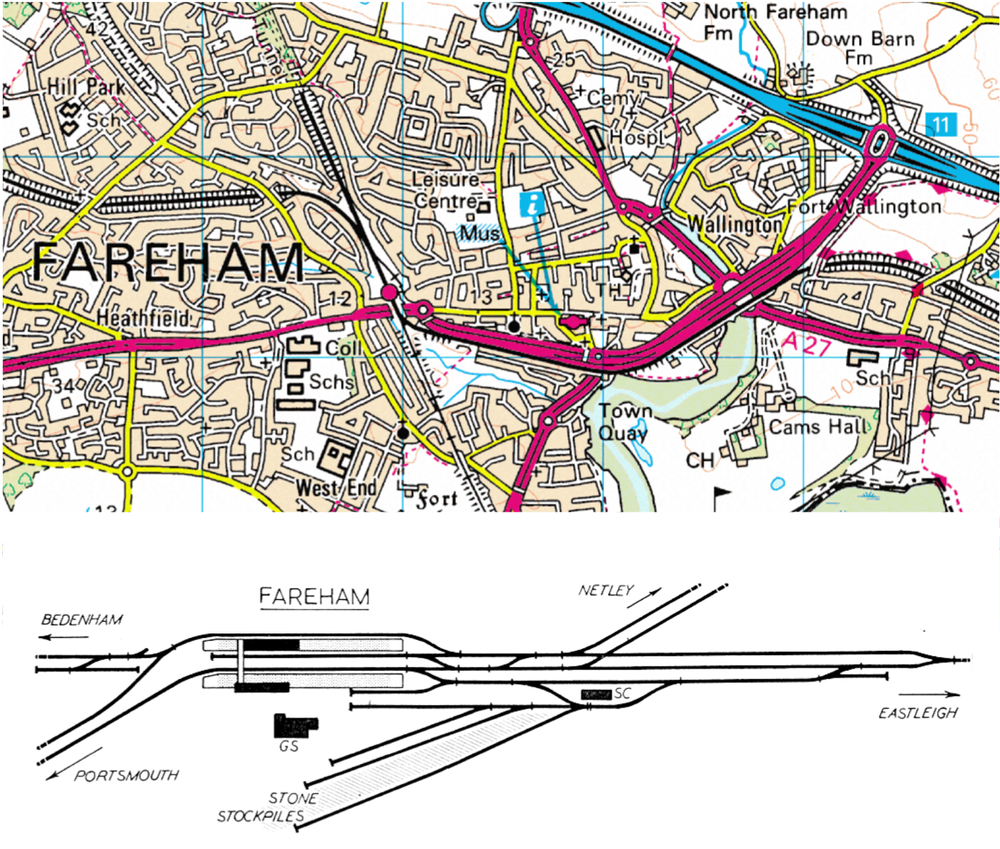
Fareham map and track diagrams from research

Some of my research photos to support planning
Planning the Layout (Not LEGO!)
After the research phase, the planning phase began. I designed this to be an OO gauge layout built out of organically shaped modular benchwork. The idea was to allow the layout to be easily moved if necessary and to show at exhibitions. The track diagram of the OO gauge layout is shown below:
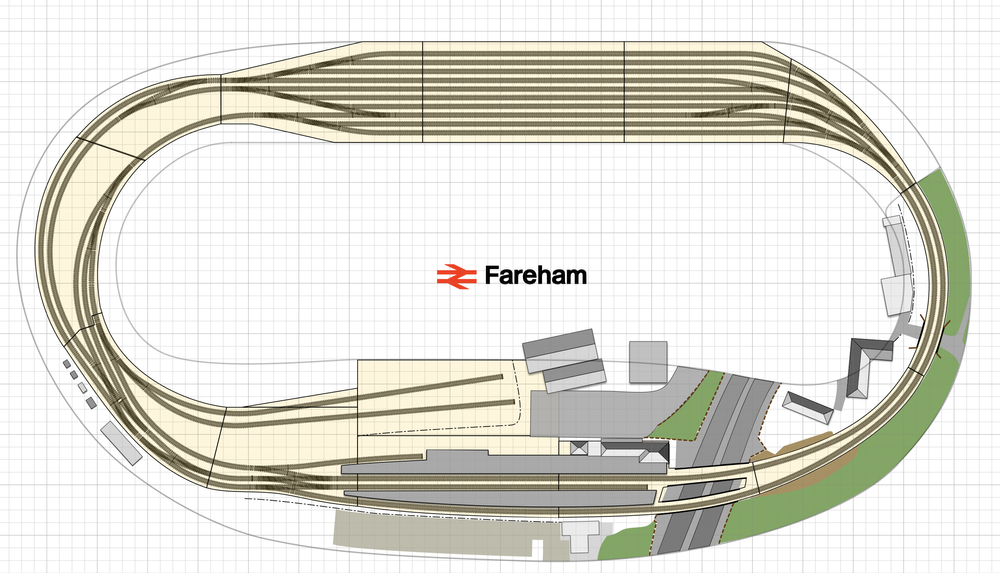
My Layout Track plan (OO Scale layout)
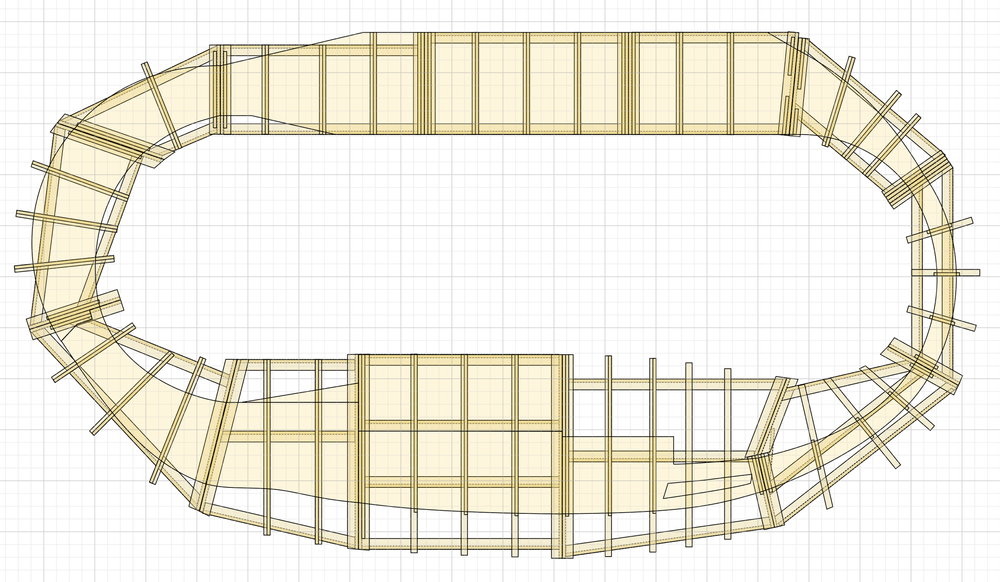
Modular benchwork design for the layout in OO SCALE
Don’t Forget the Electronics!
As an electrical engineer, I couldn’t help but indulge in the technology aspects of layout control and operation! This layout was obviously going to employ NMRA DCC (Digital Command Control) and some new technologies such as CANbus network-controlled sensors and accessory controls. Shown below is the overall electrical system design corresponding to the layout.
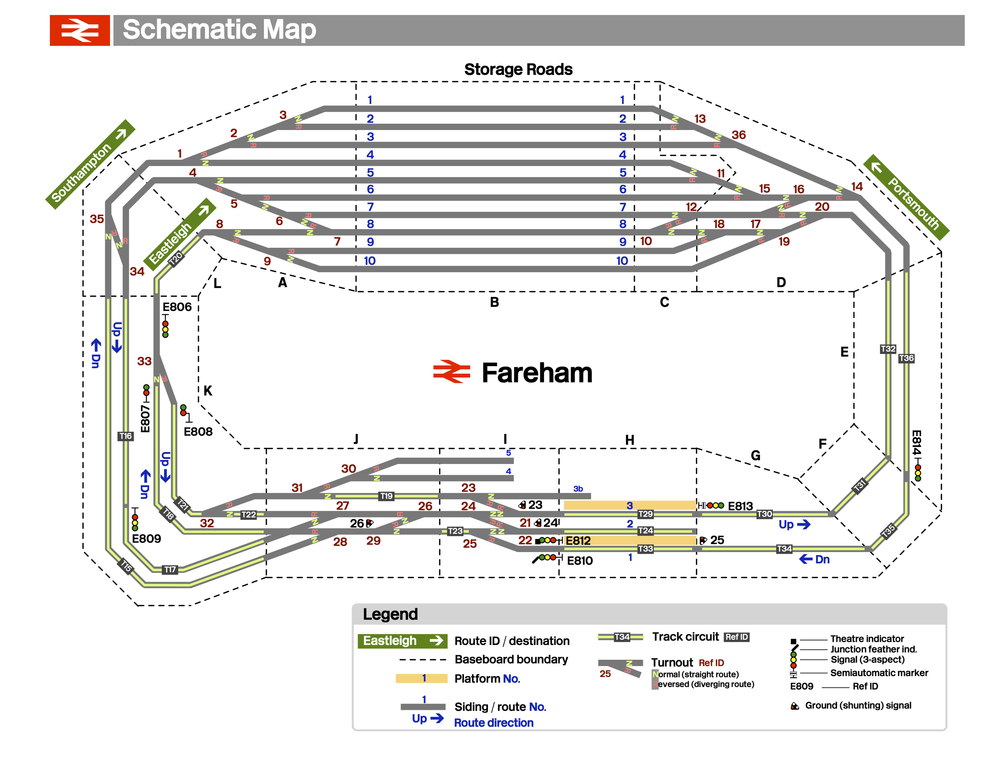
Electrical block system level diagram. This layout has block occupancy detection, electrically operated switches and realistic operating signals.
The diagram above hides the significant detail behind the electrical system design. Shown below is one of several electrical schematic diagrams detailing the power distribution and digital control network based on CANbus (an industrial control system often used in industrial automation and almost every car).

Each section of the layout has one or more sensors and actuators for signals, switches and train occupancy detection. Power and a digital canbus network link every section of the layout.
The LEGO Lightbulb
The Fareham Layout had been researched, and all the planning was more or less complete. Also, I had started purchasing track, lumber, and some electrical parts to get the project moving. Then, something happened.
I started playing with LEGO. What started as a shared activity with my kids and a rekindling of my childhood love of the brick evolved into a rapid deep dive into the LEGO train hobby community. As I became more acquainted with the hobby, it was clear that LEGO had evolved into a medium more than capable of being used in a scale model train context. And then the lightbulb moment: why not build Fareham out of LEGO?
In retrospect, it was a bonkers decision! After all of that planning and investment into an OO scale model train layout, I somehow convinced myself that it could magically be manifested into 8 mm ABS plastic blocks!
A New Plan
Now that I had committed myself to adapting a scale model train layout to LEGO, I thought it was a good opportunity to use this project as an “experiment” to see how much of the scale model train world could be “imported” into the LEGO train hobby. The first big compromise was size and scale. OO scale is 1:76 scale, and LEGO trains are built to approximately 1:40—almost doubling the scale—yet I did not want nor could I afford to have the layout occupy quadruple the footprint.
Therefore, the track plan required many compromises while retaining most of the key features that made the station and its environment recognizable. Below is the revised track plan adapted to LEGO with the same sectional modular design.
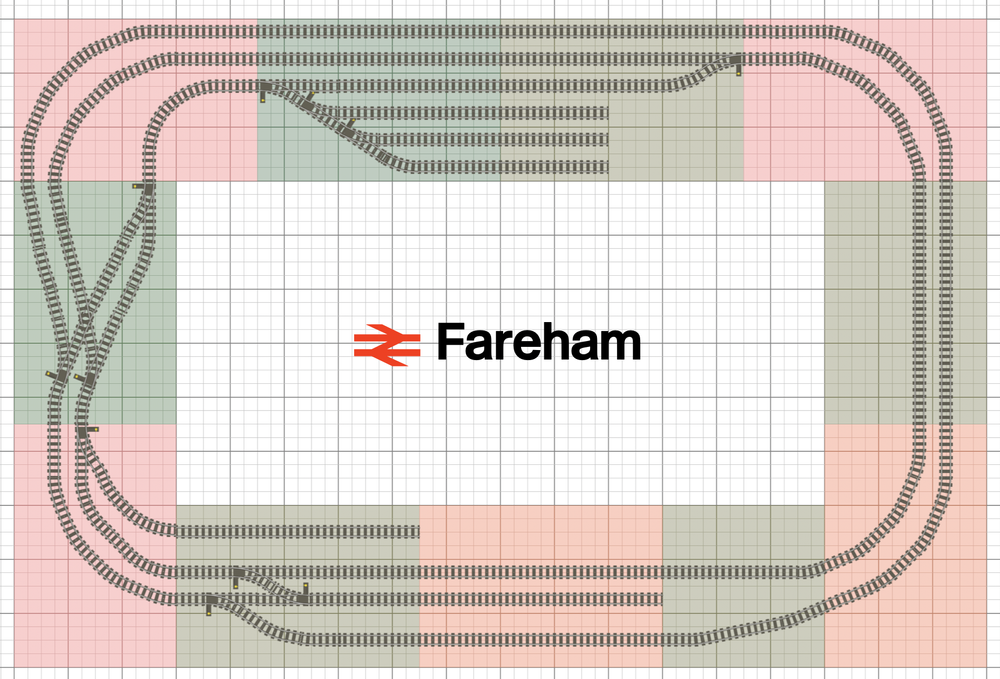
Revised Fareham layout diagram adapted to lego and built into modular tables.

Actual layout arrangement and its relationship to the real world
Modular Transport
In general, when building a model train layout in any scale, it is advisable to build the layout into independent modular sections. This has the advantages of making the layout portable and divides the building activity into discrete manageable “chunks” where you can focus on one section of the layout at a time. Below is my design concept for a modular table design for this layout.




The LEGO version of Fareham was going to incorporate all of the advanced technology I had intended for the OO gauge layout. Specifically, all trains would be controlled via DCC with an optional switchover to analog DC for either of the two main running lines (to support control of legacy 9V trains). Also, all switches and signals would be operational and controlled by a CANbus digital network.
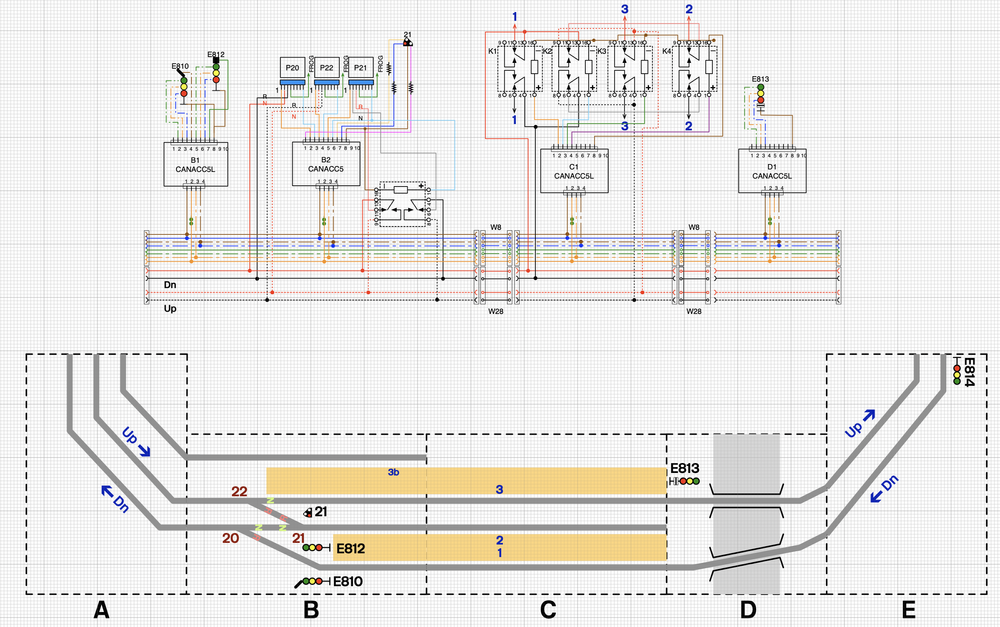
Adapting the electrical design to the LEGO version of Fareham
Construction Begins
I started building the layout, beginning with the station and the tricky double road overbridge (at the south end of the station). Building progressed over almost two years. I exhibited interim versions of the layout at various LEGO fan events, including Brickfete 2013 in Toronto and Montreal, Brickfete 2014 in Toronto and Ottawa, and Brickworld Chicago 2015. This gallery of Work In Progress (WIP) shows the progression of the layout from bare plywood to brick.
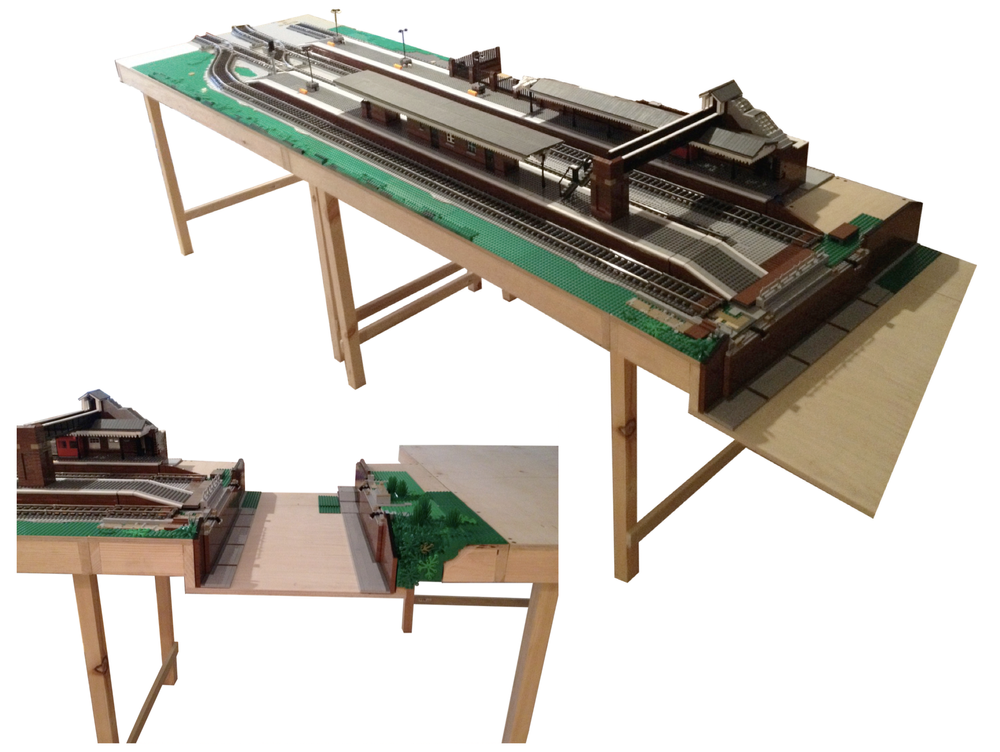
Work starts at the station south end with the double road overbridge
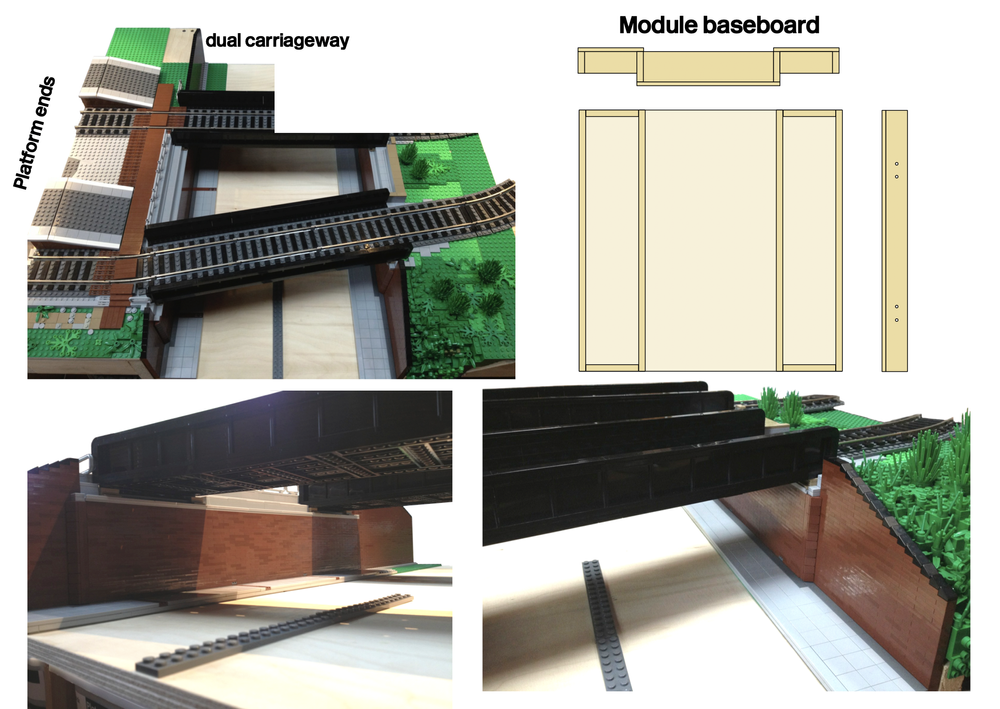
Progress on the bridges and retaining walls

The station platforms feature the typical approach ramps and built to the correct height relative to rolling stock.

The station platforms feature overhead canopies spanning a large length. They were built with a technic frame and feature integrated LED Lighting.

Progress from the north end of the station with the distinctive double track junction. Impossible to render in LEGO without building a custom element of 9V track, the 22.5º diamond crossing. To complicate matters more, I built the tracks along shallow diagonal angles to keep the layout within the table width and to give a more aesthetic organic profile.

Continuing to build from the south end of the station, I made a depiction of the fire station near the station and added a road overbridge in the corner to act as a scenic break to the back of the layout with the yard.
Keeping It Real
One key objective of building this layout was to show how LEGO bricks can be used to make a prototypical model railway with the same philosophy and fidelity that model train hobbyists use in other scales. Below are some of the features of the prototype and their corresponding representation in LEGO bricks as they appear on my layout.




By the autumn of 2013, I had managed to finish most of the southern end of the station area—enough of an excuse to put together a teaser photo montage!
Electrical Work
One of the features of this LEGO train layout is the extent of electrical wiring, circuits, and control systems that hide below the surface (permanently mounted under the table). This infrastructure powers everything from the trains to the switches, signals, and all of the electrical lighting mounted realistically across the entire layout.
The entire layout can be controlled from a laptop connected via USB to a custom-made DCC / CANbus command station and power booster. The command station's design was based on the C-Bus command station from MERG (Model Electronic Railway Group). The software to control the layout is JMRI (Java Model Railroad Interface). This software suite allows you to make a schematic diagram of your layout and define connections to actual hardware modules associated with sensors, actuators, throttles, etc.

The layout is controlled with JMRI software on a laptop connected to the layout command station. A “live” layout diagram shows the realtime position of trains, state of the signals and switches. Signals automatically transition based on train occupancy and progress on the layout. Routes can be set by clicking on the track diagram. Lastly, a virtual throttle panel allows control of several trains simultaneously.

Station platform lamps make a huge difference in setting the atmosphere of the station.
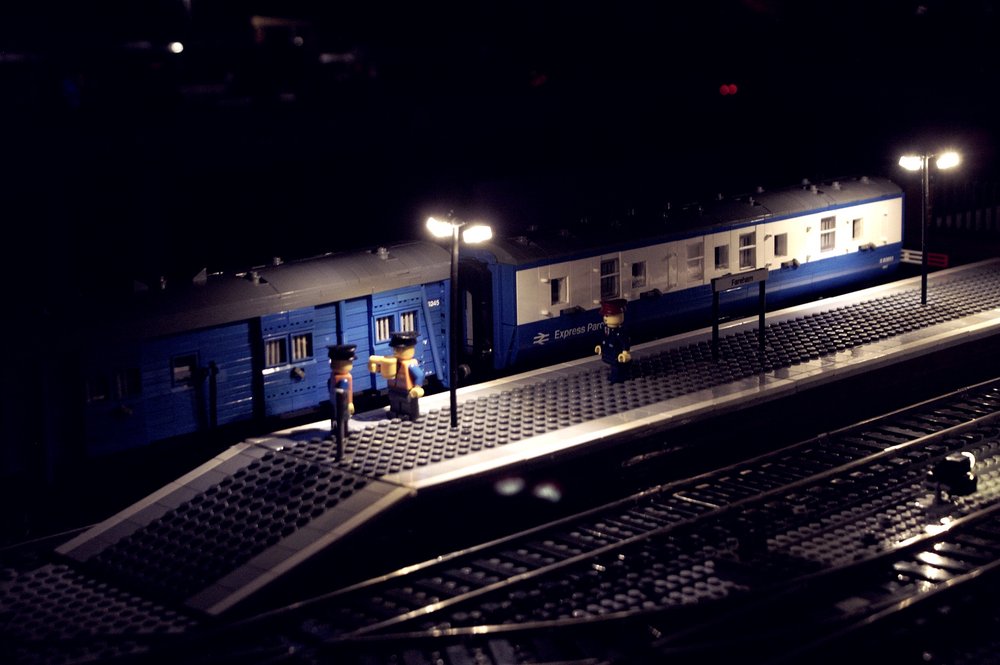
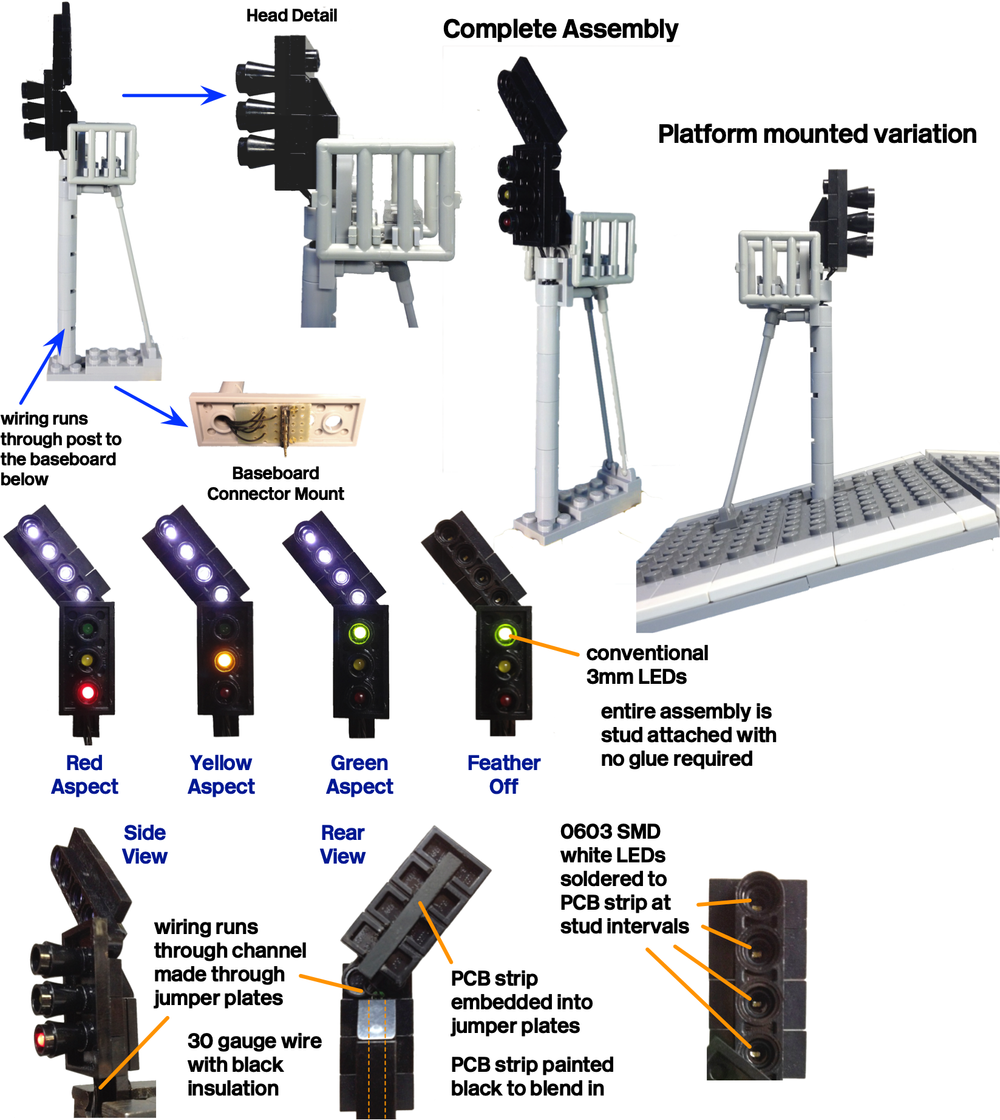
3-aspect colour light signals (of British Rail design) were made from various LEDs and Lego parts.
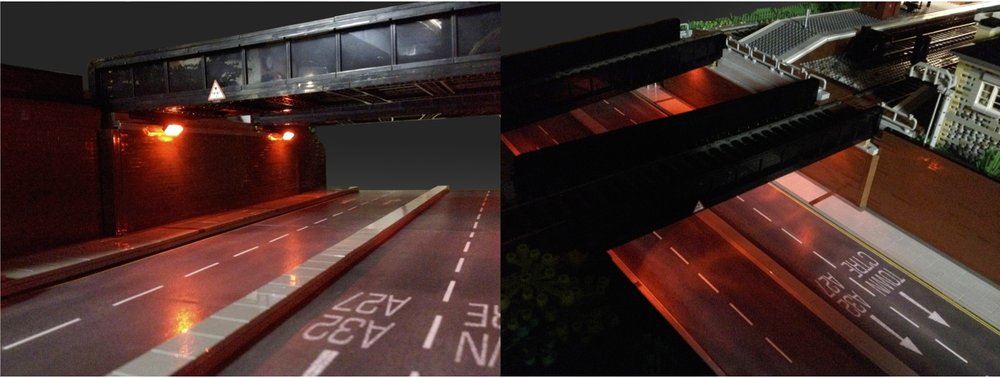
Don’t underestimate the effect of placing realistic mood lighting everywhere! The typical orange sodium lamps used for public lighting are distinctive features of any suburban environment. This also includes street lighting on other parts of the layout.

Even the yard at the back of the layout is fully illuminated with typical overhead yard lights.

Nothing brings a layout to life in the same way that realistic lighting can achieve!
Gallery Finale
To wrap up this retrospective overview of Fareham, a gallery of the finished layout honours the memory of this now-retired experiment representing countless hours of dedicated effort.
View fullsize
View fullsize

View fullsize

View fullsize

View fullsize

View fullsize

View fullsize

View fullsize

View fullsize

Final Thoughts
It is indeed bittersweet to reflect on Fareham now that it is retired. It was an ambitious experiment. I wanted to see how much of the model train world could be adapted to LEGO in key areas of:
Prototype fidelity
Methods of construction
Technology and control systems
I have convinced myself that the philosophy of being a scale model train hobbyist can happily co-exist within the world of LEGO building. However, would I do it all again—at least the same way? The honest answer is no. Building custom tables with complex electronic control systems is not compatible with the way that I now enjoy the LEGO train hobby. It is difficult to transport, set up, exhibit, and tear down for fan conventions—compromising my enjoyment of these events, which I love.
I’ve evolved into embracing a more “relaxed” view of LEGO train modeling. One that prioritizes modularity, flexibility and collaboration (with the use of MILS modules) and one that maximizes my ability to participate at LEGO fan events worldwide. I still adhere to prototype fidelity of the models themselves and I’ve unbelievably carved out a new career exploring the ways in which cool technology can be integrated into the LEGO train hobby (Fx Bricks!).
Fareham represents the start of this journey. Now it’s time to explore what comes next—stay tuned!
View fullsize
View fullsize

View fullsize

View fullsize

View fullsize

Have you ever retired a large MOC? Leave your thoughts in the comments below.
Do you want to help BrickNerd continue publishing articles like this one? Become a top patron like Charlie Stephens, Marc & Liz Puleo, Paige Mueller, Rob Klingberg from Brickstuff, John & Joshua Hanlon from Beyond the Brick, Megan Lum, Andy Price, Lukas Kurth from StoneWars, Wayne Tyler, Monica Innis, Dan Church, and Roxanne Baxter to show your support, get early access, exclusive swag and more.
